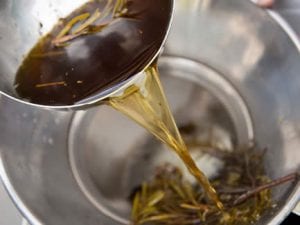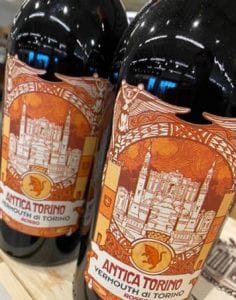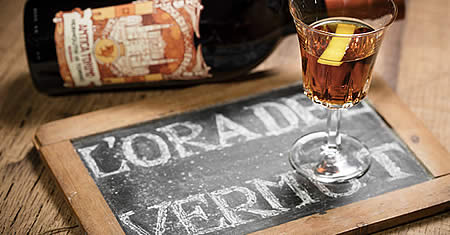By Jessica Granatiero, founder/creator of The Savory Grape.

Photo Courtesy of Antica Torino
To spring into the season with vermouth, the beautifully hued, wine-based refreshment, is a great choice during this month. A glistening white or luscious red color, vermouth has always taken second position to whiskey, gin or vodka in famous cocktails like Manhattans, Negronis, and Martinis. But this beauty is now in first position, standing on its own, and rightfully so!
Wine + Botanicals + Neutral Spirit
Vermouth though – what is this enigma? While often thought of as a spirit because it has historically being mixed with other spirits to make cocktails, vermouth is a wine-based elixir (yes, wine) that has been fortified with a neutral spirit (often brandy), and aromatized with a secret mixture of infused herbs and botanicals that add flavor, color and individual uniqueness to this delicious liquid. The easy visual to remember: Wine + Botanicals + Neutral Spirit.

Vermouth is often made from a base of white wine, though red and rose wines are also used. Vittorio Zoppi, co-owner and distiller of Italy’s Antica Torino Vermouth with Filippo Antonelli, owner of Antonelli Vineyards in Umbria, Italy uses a white wine base. He says, “This is me; others make theirs [vermouth] differently.”
Each vermouth producer has its own original recipe that it keeps very close to the chest, never revealing the true mixture or all the botanicals used. It’s like old Italian food recipes passed down for generations – certain ingredients were always left out to maintain secrecy. Some vermouth makers will use up to 30 different kinds of botanicals, like wormwood, grapefruit peel, vanilla, gentian rosemary, orange peel and liquorice root.
Vermouth ranges from dry to sweet and some in between. Dry vermouth is typically radiantly clear, and called white vermouth, bianco or blanco, depending on its country of origin. Sweet vermouth (red or rosso) is a reddish-orange hue and can get its color from aging of the base wine, caramel which is often derived naturally from one made from small artisanal producers, or from caramel coloring. The reddish, sweeter style is used to make the famous Negroni cocktail – a mix of gin, sweet vermouth and a bitter liqueur like Contratto bitter or Campari.
Like anything artisanal, small-production vermouths are often hand-crafted, while mass-produced ones are made in larger quantities as the name implies. As an example, Antica Torino artisanal vermouths begin with a base wine of which they control. For small producers, the botanical’s infusion process, like Antica Torino’s may also occur in-house, and longer thus extracting richer flavors.
Zoppi shares that their botanicals are completely natural – sans bulking agents or industrial colorants. They also cut each herb by hand, so they can acquire what they consider their “perfect extraction.” Antica Torino’s total production is only 9,000 bottles, a small number compared to larger ones who make millions of bottles. However, larger producers, like Martini & Rossi, Carpano Antica and Cinzano, thankfully paved the way for vermouth today.
Its History
Reportedly, originating in the 18th century by Antonio Benedetto Carpano, from the romantic country of Italy, specifically the city of Turin (Torino in Italian), vermouth was created for its medicinal purposes. It also had a long aristocratic history involving the Savoy family, supposedly becoming the beverage of this royalty.
But over the years, the popularity of Vermouth waxed and waned, until most recently with the cocktail resurgence and widely sought after and enjoyed Negroni. There is also the Negroni Sbagliato – translated as the mistaken Negroni – a cocktail with a history in which an Italian bartender accidentally used sparkling wine instead of gin to make the Negroni. Hence the Negroni Sbagliato was born.
Not all Vermouths, like any beverage, are created equal. While it hails from many countries – Italy, France, Spain, South Africa, the U.S. – Italy is the most popular and there is only one Vermouth di Torino. Like France did with Champagne many years ago to protect its name and quality (Champagne can’t be called Champagne unless it comes from that region and adheres to certain rules), the production of Vermouth di Torino is controlled by Italian law to ensure its quality and that others don’t call their vermouth “Vermouth di Torino” unless it adheres to its production rules. While there are great quality vermouth options simply labeled dry or sweet, the Italian designation Vermouth di Torino puts it one notch up on the quality ladder.
The Life of Vermouth and How to Drink
Like they did many years ago, Vermouth is great to prep the stomach with before a meal. This pre-meal time is referred to as Aperitivo in Italy – akin to our U.S. “Happy Hour.” In any Italian café in the early evening, you can see the relaxed atmosphere, hear the laughter and see the smiles on faces of Italian women and men as they are enjoying their “aperitivo” cocktails, involving vermouth – a relaxed environment we crave for here in the U.S.
You don’t have to go to Italy to enjoy this festive time. You can do so at home, sipping vermouth or crafting your own easy cocktails. Good vermouth, like a good Bourbon or Scotch, can be enjoyed alone, simply over ice and topped with a touch of club soda and twist of lemon or orange.

Photo Courtesy of Antica Torino
When you’re ready to explore, remember that vermouth has a certain life cycle, like wine, before its quality and flavors deteriorate. Once opened, store it in the refrigerator. It’s best enjoyed fresh and within a short time after opening. You can keep vermouth in the refrigerator for 4-6 weeks.
Expand your tastes and enjoy some of these artisanal beauties during the month of love. Actually, go enjoy any month!
Antica Torino, Vermouth di Torino, Italy
Contratto Rosso Vermouth, Piedmont, Italy
Atxa (Acha) Vermouth Bianco, Spain
Easy Cocktails to try at home.
Classic Negroni – equal parts gin, sweet vermouth and red bitter liqueur
Negroni Sbagliato – equal parts red vermouth, red bitter liqueur, sparkling wine
The post Spring & Spirit appeared first on The Savory Grape.












